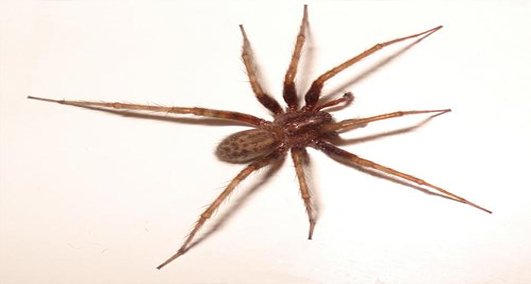
Comprehensive Guide to the Brown Recluse Spider
Overview
The Brown Recluse Spider (Loxosceles reclusa), also known as the “violin spider” or “fiddleback spider” due to the violin-shaped marking on its back, is a highly venomous spider native to the central and southern United States. While its bite can cause serious medical issues, these spiders are generally shy and avoid human interaction, biting only when they feel threatened.
Identification
- Scientific Name: Loxosceles reclusa
- Common Names: Brown Recluse Spider, Fiddleback Spider, Violin Spider
- Family: Sicariidae
- Size: 6-20 mm (about the size of a quarter)
- Color: Light to dark brown, with a characteristic violin-shaped mark on the cephalothorax (upper body). The violin “neck” points towards the rear of the spider.
Physical Characteristics:
- Legs: Long and uniformly colored, without thick spines or bands.
- Eyes: Unlike most spiders, which have 8 eyes, the Brown Recluse has 6 eyes arranged in pairs in a semicircle.
- Body Shape: Flattened appearance with a soft, bulbous abdomen.
Habitat
Brown recluse spiders thrive in dry, secluded, and dark areas. They are commonly found in:
- Indoors: Basements, attics, closets, behind furniture, or inside storage boxes. They tend to hide in clothes, shoes, bedding, and cardboard.
- Outdoors: Woodpiles, sheds, and debris piles, preferring undisturbed places.
These spiders are nocturnal hunters, coming out at night to search for prey. They do not spin webs to catch prey but use their silk to create shelters.
Behavior
- Reclusive Nature: True to their name, Brown Recluse spiders are shy and avoid human contact. They typically bite when accidentally pressed against human skin, such as when trapped in clothing or bedding.
- Feeding: They feed on small insects like cockroaches, ants, and beetles, catching prey through active hunting rather than web entrapment.
Brown Recluse Bite
A bite from a Brown Recluse can have serious medical consequences, though not all bites result in severe reactions. The spider’s venom contains enzymes that can cause necrosis (death of tissue) in extreme cases.
Symptoms of a Brown Recluse Bite:
- Initial Bite: Often painless, but may feel like a mild sting or pinprick. Some individuals report a burning sensation.
- Immediate Effects: Over several hours, redness, swelling, and a blister may form at the site.
- Severe Reactions: In some cases, a necrotic lesion (dead tissue) develops, leading to an open sore. This can take weeks to heal and may result in permanent scarring.
- Systemic Reactions: In rare cases, individuals may experience fever, chills, dizziness, rash, or muscle pain.
First Aid for Brown Recluse Bite:
- Clean the Area: Wash the bite with soap and water to reduce infection risk.
- Ice Pack: Apply a cold compress to reduce swelling and discomfort.
- Medical Attention: Seek immediate medical help if the bite worsens after 24 hours, develops into a severe lesion, or if systemic symptoms (fever, nausea) appear.
- Avoid Home Remedies: Do not attempt to drain the bite or apply heat. Always consult a healthcare provider.
Medical Treatment
- Antibiotics: If a secondary infection occurs, antibiotics may be prescribed.
- Pain Management: Over-the-counter pain relievers can help manage discomfort.
- Debridement: In severe necrotic cases, doctors may need to remove dead tissue.
- Antivenom: While there’s no specific antivenom for Brown Recluse bites, supportive care is usually sufficient.
Prevention and Control
Indoor Prevention:
- Declutter: Regularly clean closets, basements, and storage spaces where spiders might hide.
- Seal Cracks: Seal any cracks and gaps in walls, windows, or doors to prevent spider entry.
- Use Sticky Traps: Place sticky traps in corners of rooms and under furniture to capture wandering spiders.
- Wear Protective Clothing: Use gloves when moving stored items, firewood, or debris where spiders might reside.
Outdoor Prevention:
- Remove Debris: Clean up woodpiles, leaves, and unused building materials around the house to minimize outdoor hiding places.
- Control Insects: Reduce the spider’s food supply by controlling insect populations around your home.
- Inspect Firewood: Be cautious when bringing firewood or other outdoor materials into the house.
Dealing with an Infestation
While Brown Recluse spiders are not aggressive, their presence can pose a risk if they infest your home. A professional pest control service is recommended to handle infestations, particularly in areas like attics or basements where these spiders may be hard to access.
Steps for Professional Control:
- Inspection: A pest control expert will inspect your property to locate nesting sites and identify the extent of the infestation.
- Treatment: Common treatments include the use of insecticides, dusts, and traps to eliminate both adult spiders and their eggs.
- Follow-Up: A thorough pest control plan involves follow-up visits to ensure the spiders have been effectively eradicated.
Myths and Misconceptions
- Myth: All brown spiders are Brown Recluse spiders.
Fact: Many harmless brown spiders are often mistaken for Brown Recluses. Identifying the six eyes and the violin shape is crucial for accurate identification. - Myth: Brown Recluse bites are always deadly.
Fact: While their bites can cause necrosis and infection, fatalities are extremely rare, especially with proper medical care. - Myth: Brown Recluse spiders are everywhere in the U.S.
Fact: Brown Recluse spiders are native primarily to the central and southern U.S., with the highest concentrations in states like Missouri, Arkansas, and Oklahoma. They are less common in other parts of the country.
Conclusion
The Brown Recluse spider, though feared for its venomous bite, is a reclusive species that poses little threat if left undisturbed. Proper precautions can significantly reduce the chances of encountering this spider in your home or workplace. In the event of a bite, timely medical treatment is essential to prevent complications. For those dealing with infestations, professional pest control services provide the safest and most effective solution.